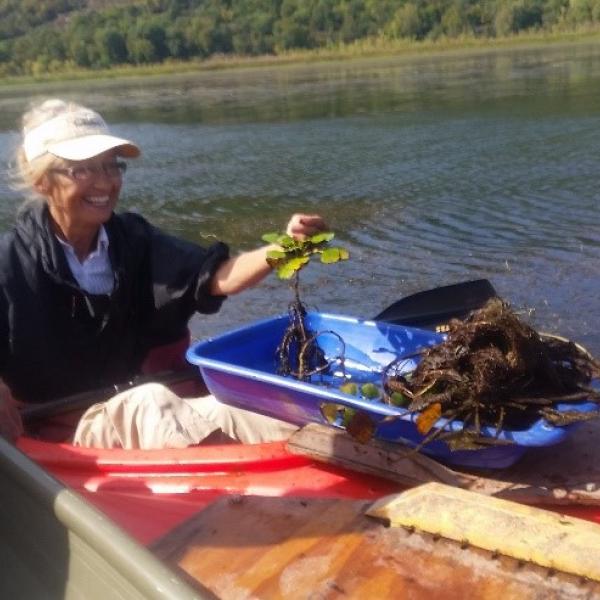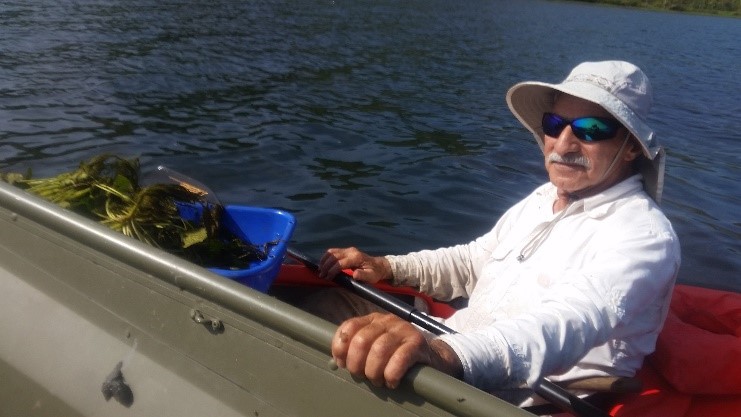
focus on the water, keep your back to the sun, and have a really strong paddle.
Water chestnut (Trapa natans) is an established invasive plant that, like many other non-native plants, escaped a cultivated life in the 1870’s to spread and grow into new territories beyond the small garden in which it once existed. Lacking any major herbivores to consume the fruit or plant, its growth consumes wide areas of water, creating impassable dense mats. The establishment of this species, if left unchecked, can severely limit boating, fishing, hunting, swimming, and other recreational activities on the water.
The first infestation of water chestnut in Vermont was recorded in the 1940’s in southern Lake Champlain. Since then, the invader has spread throughout Lake Champlain and at least thirty waterbodies. The Vermont Agency of Natural Resources (VT ANR) has been actively managing the containment and spread of the species since the 1970’s. As one of the few invasive plant species that only reproduces by seed, mechanical or hand harvesting of plants before seeds develop is a preferred method. Each summer, a crew of dedicated volunteers and professionals in various watercraft head to Lake Champlain and other water bodies to pluck the floating-leaved plant out of the water.

Pat ready to unload his bounty to scour the shoreline again.
A husband and wife team, Pat and Terry, have worked on water chestnut removal for almost twenty years. They have worked in partnership with VT ANR staff on the management of the nuisance exotic plant, and have contributed to the success of the program in reducing the area affected by water chestnut in the Lake Champlain basin. Pat’s shared wise words, “Focus on the water, keep your back to the sun, and have a really strong paddle“ touting their methodology are spot on. In fact, Pat and Terry have many tips to share to ensure a high success rate for water chestnut removal. As a team, they are a well-oiled machine and have scoured miles of the Lake Champlain shore and other water bodies each year.
Their methods may be common, “paddling and searching” and “sitting and picking,” but they have truly mastered the execution of these methods. Pat prefers to scan and monitor areas. He has inventive designs to retrofit a jon boat with a paddle wheel to get into those really shallow edges, especially when the drone he’d like to use can better pinpoint which shallow areas are best to venture in. Terry prefers to sit and pick. Focused in an almost zen-like state of precision and thoroughness, she rapidly fills a basket with a quick flick of the plant, adding to a well-organized pile.
This year, the two-person crew had another successful year on the water, removing thousands of water chestnut plants in July, August, and September. In 2018, the dynamic duo again plans to divide and conquer and pilot their kayaks to wherever water chestnut plants might lurk. They are fortunate to see, and are most likely one of the reasons for, the decrease in water chestnut numbers in Vermont over the years. Perhaps it was also their strong paddles, better to get through lily pads. With their twenty-year anniversary arriving soon, the Vermont AIS Team wanted to acknowledge their dedication and their passionate work!
Article by Kimberly Jensen. Kimberly is the new aquatic invasives plant specialist with VT ANR. She looks forward to receiving all the best tips to manage aquatic invasive plants at kimberly.jensen@vermont.gov.
Photo Credit: Kimberly Jensen, VT DEC